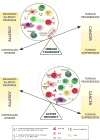AllergoOncology: Opposite outcomes of immune tolerance in allergy and cancer
- PMID: 28921585
- PMCID: PMC6038916
- DOI: 10.1111/all.13311
AllergoOncology: Opposite outcomes of immune tolerance in allergy and cancer
Abstract
While desired for the cure of allergy, regulatory immune cell subsets and nonclassical Th2-biased inflammatory mediators in the tumour microenvironment can contribute to immune suppression and escape of tumours from immunological detection and clearance. A key aim in the cancer field is therefore to design interventions that can break immunological tolerance and halt cancer progression, whereas on the contrary allergen immunotherapy exactly aims to induce tolerance. In this position paper, we review insights on immune tolerance derived from allergy and from cancer inflammation, focusing on what is known about the roles of key immune cells and mediators. We propose that research in the field of AllergoOncology that aims to delineate these immunological mechanisms with juxtaposed clinical consequences in allergy and cancer may point to novel avenues for therapeutic interventions that stand to benefit both disciplines.
Keywords: allergooncology; allergy; cancer; oncoimmunology; tolerance.
© 2017 The Authors. Allergy Published by John Wiley & Sons Ltd.
Conflict of interest statement
All authors have read and approved the position paper. None of the authors has any conflict of interest.
Figures


References
-
- Belkaid Y, Rouse BT. Natural regulatory T cells in infectious disease. Nat Immunol. 2005;6(4):353–360. - PubMed
-
- Saraiva M, O’Garra A. The regulation of IL-10 production by immune cells. Nat Rev Immunol. 2010;10(3):170–181. - PubMed
-
- Akdis M, Akdis CA. Mechanisms of allergen-specific immunotherapy: multiple suppressor factors at work in immune tolerance to allergens. J Allergy Clin Immunol. 2014;133(3):621–631. - PubMed
-
- Koebel CM, Vermi W, Swann JB, Zerafa N, Rodig SJ, Old LJ, et al. Adaptive immunity maintains occult cancer in an equilibrium state. Nature. 2007;450(7171):903–907. - PubMed
Publication types
MeSH terms
Grants and funding
LinkOut - more resources
Full Text Sources
Other Literature Sources
Medical

